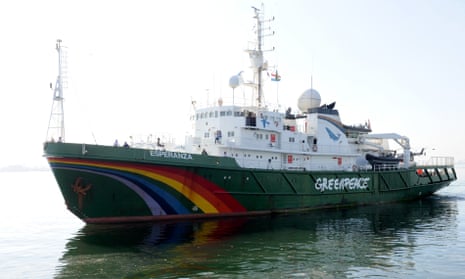Scientists aboard a Greenpeace ship have discovered a massive and unique coral reef near the mouth of the Amazon, in an area where the French company Total intends to drill for oil.
The 1,000km long and 56,000 sq km Amazon coral reef is a biome thought to contain dozens of undiscovered species that environmentalists say would be irreparably damaged if drilling for oil began – a vision at odds with the wish of oil companies hoping to explore the area’s vast estimated reserves.
The reef was discovered in 2016, but Greenpeace’s latest find shows that it extends into the area where Total plans to drill. The Brazilian government has estimated that the Foz de Amazonas, or Amazon Mouth area, could hold 15.6bn barrels of oil.
A group of oil companies led by French company Total that included BP and Brazil’s state oil giant Petrobras acquired rights to five exploration blocks in a 2013 auction.
Greenpeace says that the recent discovery of coral in Total’s FZA-M-86 block, located 120km off the coast of the Amazon state of Amapá, invalidates the company’s last environmental impact assessment and their estimation that corals would be 30% affected in the event of an oil spill.
“The fact that the business didn’t communicate there was coral inside the block indicates a huge failure in their environmental impact assessment,” Greenpeace Brazil campaigner Thiago Almeida told the Guardian, speaking from the groups’s ship Esperanza.
“Therefore we question how they can affirm that the risk is 30% and what the level of impact would be on the corals, if they don’t even know where the corals are?” he said.
Experts have said that the vast unexplored biome could be utilized for medical research to treat cancer and infectious diseases.
“It could be considered like an underwater drug store,” said Fabiano Thompson, oceanographer and professor at Rio de Janeiro Federal University, who spent 10 days aboard Greenpeace’s Esperanza ship and was there when the coral was discovered.
Thompson said an oil spill could also cause irreparable damage to marine life production in the region, destroying the livelihoods of fishermen and traditional communities and the local economies of Amapá, Pará and Maranhão, three of Brazil’s poorest states.
Meanwhile, campaigners say any potential benefits of oil exploration to the local population would be minimal. Total and BP have confirmed that barely be any jobs generated by the project.
In August, Brazil’s government environment agency Ibama denied Total’s environmental impact assessment application.
Total has applied for a drilling another licence in the region which is due to be decided on in the next few weeks and if granted, operations could start as early as this year.
Total did not immediately respond to a request for comment.
